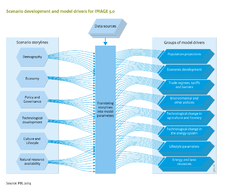Drivers/Policy issues: Difference between revisions
< Drivers
Jump to navigation
Jump to search
No edit summary |
No edit summary |
||
| Line 6: | Line 6: | ||
Under baseline conditions, scenario drivers are assumed to develop either along the pathway considered the ‘best guess’ translation of current trends into the future, or multiple contrasting scenarios are considered to explore the range of plausible future trends. The first approach has been chosen for many studies, such as the OECD Environmental Outlook to 2050 ([[OECD, 2012]]), as starting point for policy interventions to improve the baseline outcomes within and across sectors and issues. The second approach recognises structural uncertainties in how the world may develop, and explores how such uncertainties would play out in a future range of outcomes. Multiple contrasting scenarios also serve to investigate how robust policy interventions play out under different future conditions. Examples of multiple baseline studies are the Special Report on Emissions Scenarios ([[IPCC, 2000]]) and the Millennium Ecosystem Assessment ([[MA, 2005]]). | Under baseline conditions, scenario drivers are assumed to develop either along the pathway considered the ‘best guess’ translation of current trends into the future, or multiple contrasting scenarios are considered to explore the range of plausible future trends. The first approach has been chosen for many studies, such as the OECD Environmental Outlook to 2050 ([[OECD, 2012]]), as starting point for policy interventions to improve the baseline outcomes within and across sectors and issues. The second approach recognises structural uncertainties in how the world may develop, and explores how such uncertainties would play out in a future range of outcomes. Multiple contrasting scenarios also serve to investigate how robust policy interventions play out under different future conditions. Examples of multiple baseline studies are the Special Report on Emissions Scenarios ([[IPCC, 2000]]) and the Millennium Ecosystem Assessment ([[MA, 2005]]). | ||
Recently, the Shared Socioeconomic Pathways ({{AbbrTemplate|SSP}}s) have been developed to support climate change research by different research communities ([[Moss et al., 2010]]; [[Van Vuuren et al., 2012]]; [[Ebi et al., 2013]]). See Figures ****. The qualitative narratives or storylines characterising alternative futures are important elements of the SSPs From there, assumptions are made about internally coherent sets of scenario drivers, and key model drivers, such as population and | Recently, the Shared Socioeconomic Pathways ({{AbbrTemplate|SSP}}s) have been developed to support climate change research by different research communities ([[Moss et al., 2010]]; [[Van Vuuren et al., 2012]]; [[Ebi et al., 2013]]). See Figures ****. The qualitative narratives or storylines characterising alternative futures are important elements of the SSPs From there, assumptions are made about internally coherent sets of scenario drivers, and key model drivers, such as population and {{AbbrTemplate|GDP}} growth ([[IIASA, 2013]]) | ||
The wide range of long-term populations projections is presented in Figure 3.2***. By 2100, the world population could be either about the same as today or double. The projections were made by IIASA using a population modelling approach (Lutz and KC, 2010) that links aggregate education levels to fertility and mortality rates per country. Together with migration flows, these rates determine the size of the future population. (Dellink et al., forthcoming; KC and Lutz, forthcoming). | The wide range of long-term populations projections is presented in Figure 3.2***. By 2100, the world population could be either about the same as today or double. The projections were made by IIASA using a population modelling approach (Lutz and KC, 2010) that links aggregate education levels to fertility and mortality rates per country. Together with migration flows, these rates determine the size of the future population. (Dellink et al., forthcoming; KC and Lutz, forthcoming). | ||
Revision as of 15:39, 9 May 2014
Parts of Drivers/Policy issues
| Projects/Applications |
| Models/Databases |
| Relevant overviews |
| Key publications |
| References |
